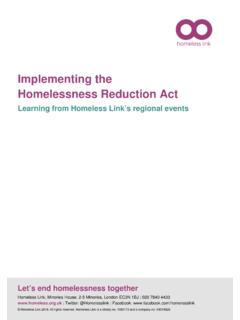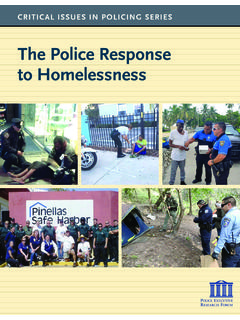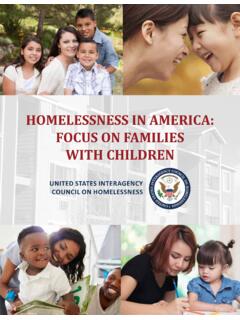Transcription of 1. Fundamental Principles of Harm Reduction
1 The Community Model developed by Lamp Community is based on a harm Reduction . service philosophy treatment focused on reducing the negative consequences of addiction and mental illness. The effectiveness of this approach is reinforced with a second, agency-wide emphasis on building community a continual, collective effort by both staff and members1 to show how every individual is part of a larger whole. The approach seeks out opportunities to both draw from and contribute to strengthening an often underused resource the individual members of the homeless and formerly homeless community. It is this focus on both harm Reduction and When we talk about what we do, community that has made the Community Model just using the word community' is particularly effective at serving chronically a huge statement, says Paul homeless people.
2 Many members of this group Alderson, the director of Lamp have never had a say in directing the course of Community's newest program, funded by the federal Collaborative their recovery; few have had the opportunity to Grant to Help End Chronic be members of an affirmative and supportive Homelessness. Very consciously, community. The Community Model makes it we're saying we're not an possible for them to realize both of these organization, we're not an agency, experiences. The following pages explore the we're not a corporation we're a community. That's a rare thing, general precepts of 1) harm Reduction and 2). and it's emphasized right from the community building, as the two are understood very first day of employee within the context of the Community Model. orientation.. This will be followed with more specific discussions of the Community Model's Characteristics and Components.
3 1. Fundamental Principles of harm Reduction What is harm Reduction ? harm Reduction is a set of practical strategies that help people reduce the negative consequences of drug use, alcoholism and mental illness by addressing the conditions of use and treatment. Rather than focusing solely and immediately on cessation of drug use or acceptance of mental health treatment, harm Reduction makes improving the quality of the individual's life, health and wellbeing the primary criteria for success. 1. This manual uses the terminology of Lamp Community, which refers to program participants as members. In addition, the term drugs can be understood to include not just illicit drugs, but also alcohol and legal drugs used without prescriptions. 11. Practitioners often say that harm Reduction strategies meet people where they're at.
4 They mean that harm Reduction does not impose one treatment goal (total abstinence or a psychotropic medication regimen) on every individual. Instead, the course and pace of treatment is determined by the individual; the practitioner's role is to educate that person on available treatment options and the consequences of his or her choices. In this way, the practitioner provides support and guidance to help individuals determine themselves how to improve their health and wellbeing, whether through medication, behavioral therapies, safer use of drugs, managed drug use or abstinence. Ambivalence and relapse are not unexpected, and are not reasons to cut off services or take away housing. Services are always voluntary, flexible and readily accessible. Some mainstream substance abuse providers view A lot of shelter providers are harm Reduction strategies as controversial or intimidated by harm Reduction .
5 Ineffective. Many subscribe to the more common says Shannon Murray, Lamp therapeutic community model of drug treatment. Community's Deputy Director and chief clinician. They think, Oh, The therapeutic community surrounds the no, everybody in the shelter is individual with a highly-structured environment going to start getting high!' The isolated from his or her normal surroundings. This fact is, there are probably people environment reinforces abstinence with intensive there who are already using drugs. counseling, peer pressure and medical treatment of Acknowledging this allows a more honest and open relationship with the disease of addiction. This method has helped the member. This is what starting many motivated individuals achieve sobriety. where the person is at' really However, therapeutic community providers have means.
6 Had considerably less success treating chronically homeless people, people with dual diagnoses and other persons facing extensive barriers to independence and self-sufficiency. The non- judgmental and graduated nature of harm Reduction services offers a viable treatment alternative for these more vulnerable groups. Defining Principles of harm Reduction harm Reduction is practiced in a variety of ways by different providers. The Community Model follows an interpretation of harm Reduction modified specifically to address treatment issues facing people with mental illness or dual diagnoses of mental illness and substance abuse. The Community Model's harm Reduction philosophy can be defined by the following Principles :2. Mental illness and addiction are public health concerns, not criminal justice or moral issues.
7 Rather than respond with condemnation or enforcement, harm Reduction focuses on minimizing the harmful effects of mental illness and addiction, both on the individual and on society. 2. These Principles are modified from harm Reduction Principles developed by the harm Reduction Coalition. For more information and training resources on harm Reduction strategies, go to , the website of the harm Reduction Coalition. 12. Improving quality of life of the individual, the community and society at large is the primary criteria for measuring the success of interventions and policies. While abstinence is undoubtedly a positive outcome of treatment, for some addicted persons, managed and safer use of drugs may be a more realistic (and still beneficial) goal. Similarly, psychotropic medications can work wonders for many people, but can be ineffective for others.
8 For some, the side effects of medication may outweigh the benefits. Rather than imposing a predetermined goal, all interventions are measured by the simple question, Does it improve the health and wellbeing of the individual and those around him or her? . harm Reduction also acknowledges the many severe and lasting harms and dangers associated with untreated mental illness and drug use. Some ways of treating mental illness and using drugs are clearly safer than others. harm Reduction offers a range of treatment options and levels of sobriety to increase the chances of successful treatment, not to devalue abstinence. Says Mollie Lowery, Lamp Community's founder, To practice harm Reduction without offering every avenue to recovery available just doesn't make sense. Twelve-step groups are as much a part of harm Reduction as needle exchanges.
9 Choice is essential for recovery. Individuals with mental illness or addiction are capable of making competent, informed decisions about the goals and consequences of their treatment and behavior. With education, guidance and support, they are the persons best situated to determine the course and pace of their treatment. Socio-economic and biological factors influence people's vulnerability to mental illness and addiction. Poverty, class, racism, social isolation, past trauma, gender discrimination and other social inequalities all affect both people's susceptibility to mental illness and drug-related harms, as well as their capacity for effectively dealing with these problems. 2. The Importance of Community Community-Building Principles Like most programs using harm Reduction strategies to address homeless people's mental illness and addiction problems, the Community Model harnesses the power of community to help homeless people improve the quality of their lives.
10 As its name implies, the Community Model puts perhaps even more emphasis on building community than other harm Reduction programs so much so that it is perhaps the most important element in the success of its programs and services. A few Principles direct the Community Model's focus on community: Services are provided to the individual in the community in which he or she resides. While some interventions may occasionally require leaving the 13. community for limited periods of time (hospitalization, medical detoxification or, if desired by the member, residential substance abuse treatment), the Community Model attempts to provide all necessary services and supports to the individual where they live. In this way, new, healthier behaviors are learned and adopted in the context of the community in which the individual will need to maintain them in order to continue a healthier way of life.








